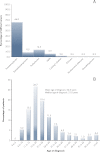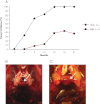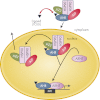Familial isolated pituitary adenomas (FIPA) and the pituitary adenoma predisposition due to mutations in the aryl hydrocarbon receptor interacting protein (AIP) gene
- PMID: 23371967
- PMCID: PMC3610678
- DOI: 10.1210/er.2012-1013
Familial isolated pituitary adenomas (FIPA) and the pituitary adenoma predisposition due to mutations in the aryl hydrocarbon receptor interacting protein (AIP) gene
Abstract
Pituitary adenomas are one of the most frequent intracranial tumors and occur with a prevalence of approximately 1:1000 in the developed world. Pituitary adenomas have a serious disease burden, and their management involves neurosurgery, biological therapies, and radiotherapy. Early diagnosis of pituitary tumors while they are smaller may help increase cure rates. Few genetic predictors of pituitary adenoma development exist. Recent years have seen two separate, complimentary advances in inherited pituitary tumor research. The clinical condition of familial isolated pituitary adenomas (FIPA) has been described, which encompasses the familial occurrence of isolated pituitary adenomas outside of the setting of syndromic conditions like multiple endocrine neoplasia type 1 and Carney complex. FIPA families comprise approximately 2% of pituitary adenomas and represent a clinical entity with homogeneous or heterogeneous pituitary adenoma types occurring within the same kindred. The aryl hydrocarbon receptor interacting protein (AIP) gene has been identified as causing a pituitary adenoma predisposition of variable penetrance that accounts for 20% of FIPA families. Germline AIP mutations have been shown to associate with the occurrence of large pituitary adenomas that occur at a young age, predominantly in children/adolescents and young adults. AIP mutations are usually associated with somatotropinomas, but prolactinomas, nonfunctioning pituitary adenomas, Cushing disease, and other infrequent clinical adenoma types can also occur. Gigantism is a particular feature of AIP mutations and occurs in more than one third of affected somatotropinoma patients. Study of pituitary adenoma patients with AIP mutations has demonstrated that these cases raise clinical challenges to successful treatment. Extensive research on the biology of AIP and new advances in mouse Aip knockout models demonstrate multiple pathways by which AIP may contribute to tumorigenesis. This review assesses the current clinical and therapeutic characteristics of more than 200 FIPA families and addresses research findings among AIP mutation-bearing patients in different populations with pituitary adenomas.
Figures










References
-
- Daly AF, Rixhon M, Adam C, Dempegioti A, Tichomirowa MA, Beckers A. 2006. High prevalence of pituitary adenomas: a cross-sectional study in the province of Liege, Belgium. J Clin Endocrinol Metab 91:4769–4775 - PubMed
-
- Fontana E, Gaillard R. 2009. Epidemiology of pituitary adenoma: results of the first Swiss study. Rev Med Suisse 5:2172–2174 - PubMed
-
- Fernandez A, Karavitaki N, Wass JA. 2010. Prevalence of pituitary adenomas: a community-based, cross-sectional study in Banbury (Oxfordshire, UK). Clin Endocrinol (Oxf) 72:377–382 - PubMed
-
- Melmed S. 2011. Pathogenesis of pituitary tumors. Nat Rev Endocrinol 7:257–266 - PubMed
Publication types
MeSH terms
Substances
Supplementary concepts
LinkOut - more resources
Full Text Sources
Other Literature Sources
Medical
Molecular Biology Databases
Miscellaneous

